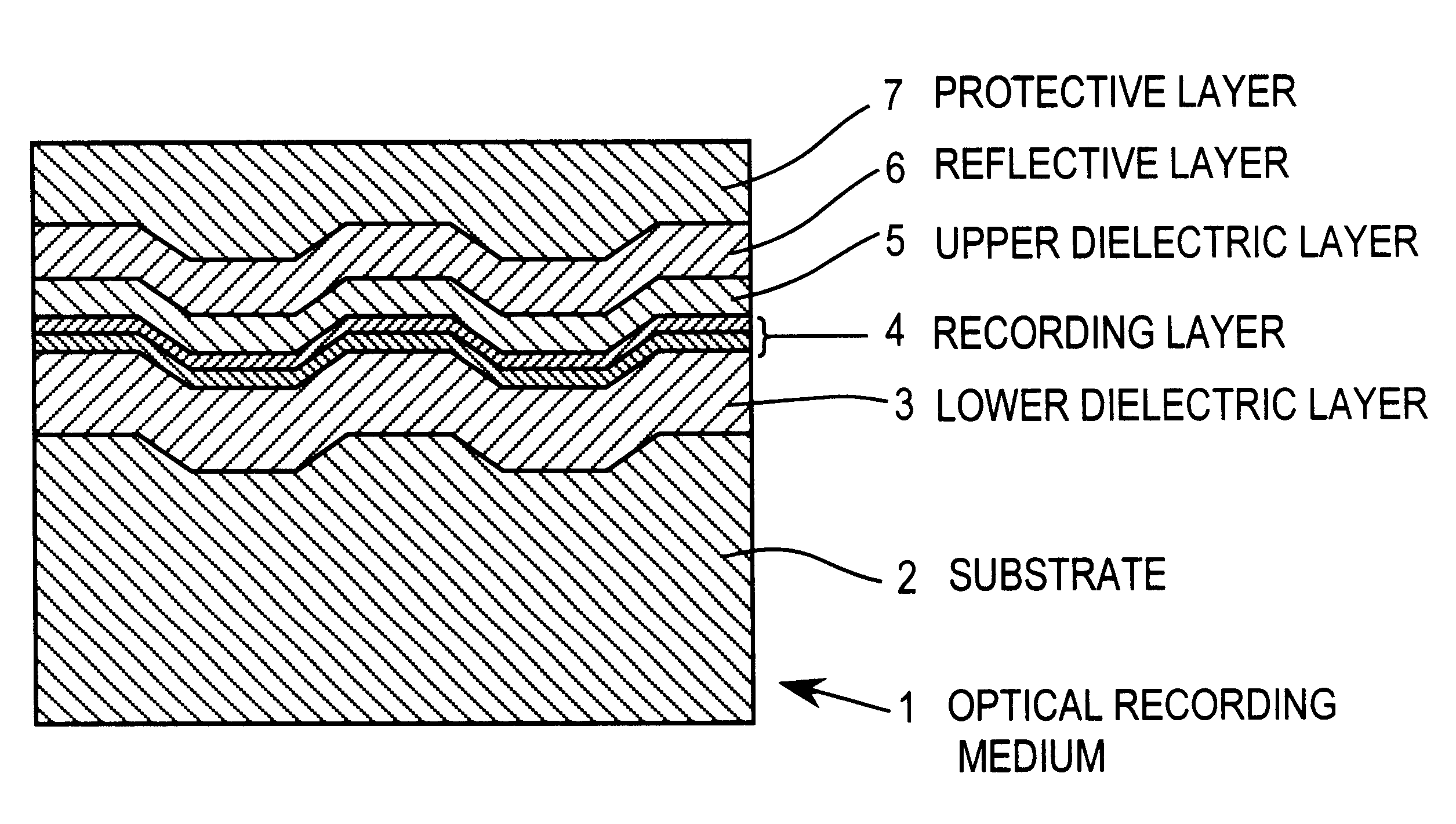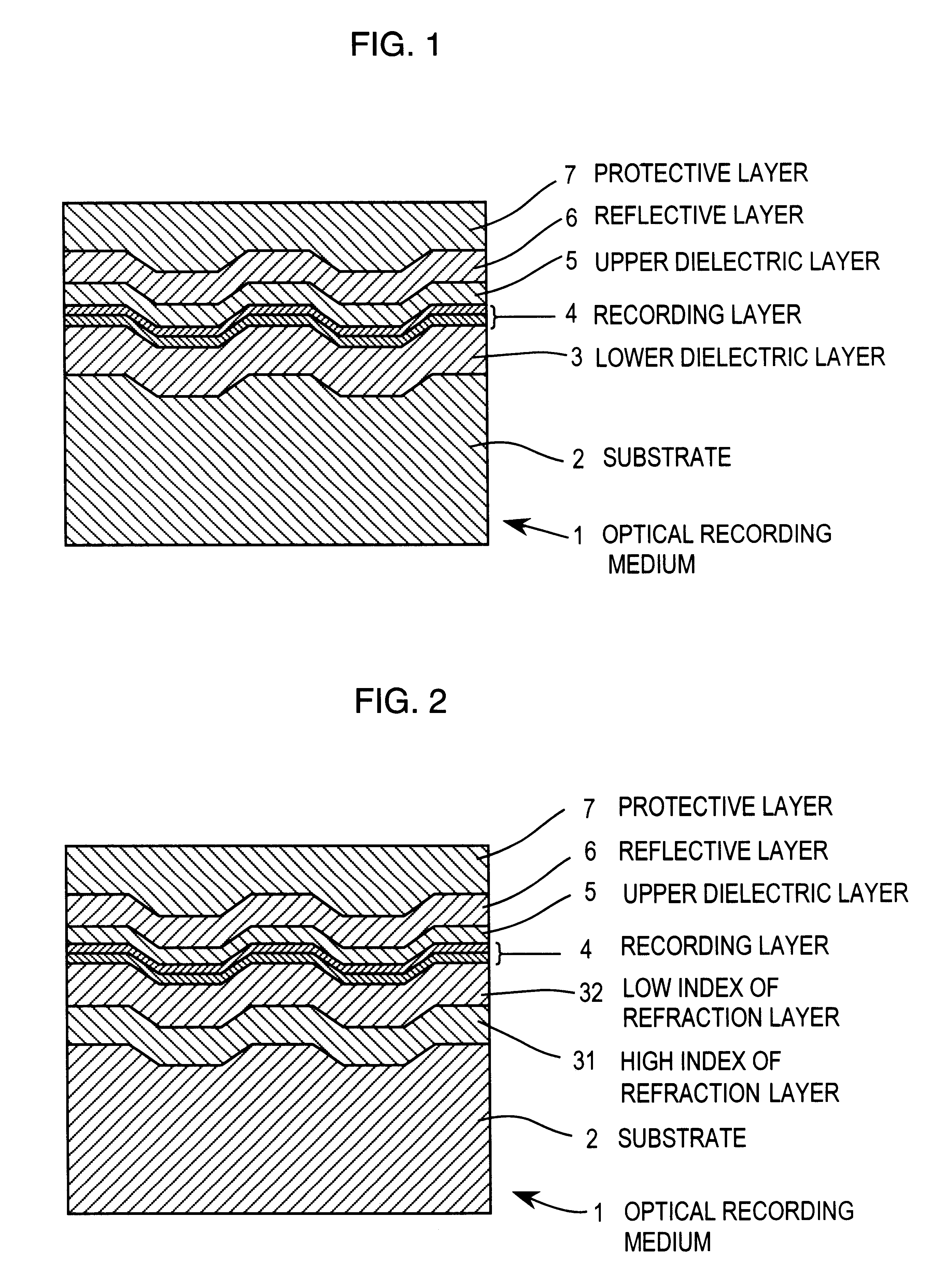Optical recording medium and method for making
a technology of optical recording medium and optical recording medium, which is applied in the manufacture of optical recording carriers, record information storage, nuclear engineering, etc., can solve the problems of low productivity, long time, and the inability to use inexpensive resin substrates in the heating of the overall medium
- Summary
- Abstract
- Description
- Claims
- Application Information
AI Technical Summary
Benefits of technology
Problems solved by technology
Method used
Image
Examples
example 1
In--Ag--Te--Sb System (Sb thin film.fwdarw.reactive thin film)
An optical recording disc as shown in FIG. 1 was prepared by injection molding polycarbonate into a disc shaped substrate 2 having a diameter of 120 mm and a thickness of 0.6 mm. A groove was formed in one major surface of the substrate simultaneous with injection molding. The groove had a width of 0.74 .mu.m, a depth of 650 .ANG., and a pitch of 1.48 .mu.m. On the grooved surface of the substrate, there were formed a lower dielectric layer 3, a recording layer 4, an upper dielectric layer 5, a reflective layer 6, and a protective layer 7.
The lower dielectric layer 3 was formed by sputtering a target of ZnS and SiO.sub.2. The value of SiO.sub.2 / (ZnS+SiO.sub.2) was 15 mol %. The lower dielectric layer had a refractive index of 2.33 at wavelength 780 nm and a thickness of 2,000 .ANG..
Next, a vacuum chamber of a sputtering apparatus was evacuated to a vacuum of 0.04.times.10.sup.-2 Pa and then charged with argon gas to a pr...
example 2
In--Ag--Te--Sb System (reactive thin film.fwdarw.Sb thin film)
A sample 2 was prepared by the same procedure as sample 1A in Example 1 except that formation of the reactive thin film was followed by formation of the antimony thin film. The ultimate gas pressure of the vacuum chamber in the recording layer forming step was the same as in Example 1. Sample 2 had a reflectance of 13%. Electron beam diffractometry analysis showed that the antimony thin film was crystalline while the reactive thin film was amorphous.
Sample 2 was subjected to mixing of the antimony thin film and the reactive thin film as in sample 1A. After the laser beam irradiation, the reflectance decreased to 10% as in sample 1A, indicating full intermixing.
Sample 2 was examined for record / erase characteristics as in sample 1A. The reflectance after recording and the C / N of a 7T (249.48 ns) signal were the same as in sample 1A. Like sample 1A, sample 2 showed a stable rate of erasure of -30 dB from the 1st overwriting ...
example 3
In--Ag--Te--Sb System (V added)
A sample 3 was prepared by the same procedure as sample 1A in Example 1 except that the composition of the antimony thin film was changed to Sb.sub.99 V.sub.1. The ultimate gas pressure of the vacuum chamber in the recording layer forming step was the same as in Example 1. Sample 3 had a reflectance of 15%. Electron beam diffractometry analysis showed that the antimony base thin film was crystalline.
Sample 3 was subjected to mixing of the antimony base thin film and the reactive thin film as in sample 1A. After the laser beam irradiation, the reflectance decreased to 13%.
Next, sample 3 was examined for record / erase characteristics as in sample 1A except that the recording power was slightly increased to 12 mW. Sample 3 had a reflectance of 20% in the crystalline region where the erasing power was applied, which was equal to sample 1A, and 6% in the amorphous region or the record mark, which was lower than sample 1A. The C / N of a 7T (249.48 ns) signal w...
PUM
| Property | Measurement | Unit |
|---|---|---|
| thickness | aaaaa | aaaaa |
| linear velocity | aaaaa | aaaaa |
| diameter | aaaaa | aaaaa |
Abstract
Description
Claims
Application Information
 Login to View More
Login to View More - R&D
- Intellectual Property
- Life Sciences
- Materials
- Tech Scout
- Unparalleled Data Quality
- Higher Quality Content
- 60% Fewer Hallucinations
Browse by: Latest US Patents, China's latest patents, Technical Efficacy Thesaurus, Application Domain, Technology Topic, Popular Technical Reports.
© 2025 PatSnap. All rights reserved.Legal|Privacy policy|Modern Slavery Act Transparency Statement|Sitemap|About US| Contact US: help@patsnap.com


